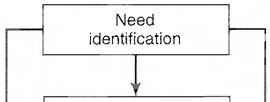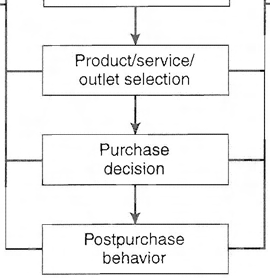CHAPTER 4
UNDERSTANDING BUYER BEHAVIOR
No wonder they have become the target of marketing campaigns so sophisticated as to
make the kid-aimed pitches of yore look like, well, Mickey Mouse.
Marketers who had long ignored children now systematically pursue them-even
when the tykes are years away from being able to buy their products. "Ten years ago it
was cereal, candy, and toys. Today it's also computers and airl ines and hotels and
banks," says Julie Halpin, general manager of Saatchi & Saatchi Advertising's Kid Con-
nection Division. "A lot of people are turning to a whole segment of the population they
haven' t been talking to before."
Those businesses that have always targeted kids, such as fast-food restaurants and
toymakers, have stepped up their pitches, hoping to reach kids earlier and bind
more tightly. Movies , T-shirts, hamburger wrappers, and dolls are all part of the cross-
promotional blitz aimed at convincing kids to spend. The c umulative effect of initiating
children into a consumerist ethos at an early age may be profound. As kids take in the
world around them, many of their cultural encounters-from books to movies to TV-
have become little more than sales pitches. Even their classrooms are filled with corpo-
rate logos . To quote cl inical psychologist Mary Pipher, "Instead of transmitting a sense
of who we are and what we hold important, today 's marketing-driven culture is instilling
in them the sense that little exists without a sales pitch attached and that self-worth is
somethi ng you buy at a shopping mall."
Some wonder if marketers are creating a relationship with consumers too soo;, and
for all the wrong reasons.
Sou rces: David Leonhardt. "Hey
Buy This," Business Week. June 30. 1997. p. 65-67; Larry Armstrong. "Pssst! Come Inlo My Web." Bll siness Week. Ju ne 30,1 997. p. 67; Tom McGee, "Gening Inside Kid s Heads," American Demographics, January 1997, pp. 53- 59: "Kids These Days," Ame rican
April 2000, pp. 9- 10; Joan Raymond, "Kids Just Wanna Have
Fun," American Demographics, Fe bru ary 2000, pp . 57- 61.
INTRODUCTION
As noted, many of the parents of today's kids are the baby boomers marketers have been
tracking for over forty years. Primarily, their importance is based on their group's enor-
mous size. Just as important, however, is that they have a great deal in common; some demo-
graphics, such as age, income, and health; some shared
such as college for their
children, retirement, and diminishing health; and some behaviors such as voting Republi-
can, eati ng out, and buying expensive walking shoes . Nevertheless, they still remain indi-
viduals who were brought up in a unique fam ily and retain a personal way of thinking and
behaving. The ultimate challenge facing marketers is to understand the buyer both as an
individual and as a member of society so that the buyer's needs are met by the product offered
by the marketer. The purpose of this chapter is to present a discuss ion of several of the key
buyer behaviors considered important to marketers .
BUYER BEHAVIOR AND EXCHANGE
As noted in an earlier chapter, the relationship between the buyer and the seller exists through a phenomenon called a marke t exchange. The exchange process allows the parties to assess the relative trade-offs they mu st make to satisfy their respective needs and wants. For the







BEHAVIOR AS PROBLEM SOLVING
75
marketer, analysis of these trade-offs is guided by company polices and objectives. For exam-
ple, a company may engage in exchanges only when the profit margin is 10% or greater.
The
the other member in the exchange, also has personal policies and objectives that
guide their responses in an exchange. Unfortunately, buyers seldom write down their per-
sonal policies and objectives. Even more likely, they often don't understand what prompts
them to behave in a particular manner. This is the mystery or the "black box" of buyer behavior that makes the exchange process so unpredictable and difficult for marketers to understand.
Buyers are essential partners in the exchange process. Without them, exchanges would
stop. They are the focus of successful marketing ; their needs and wants are the reason for
marketing. Without an understanding of buyer behavior, the market offering cannot possi-
bly be tailored to the demands of potential buyers. When potential buyers are not satisfied,
exchange falters and the goals of the marketer cannot be met. As long as buyers have free
choice and competitive offerings from which to choose, they are ultimately in control of
the marketplace.
A market can be defined as a group of potential buyers with needs and wants and the
purchasing power to satisfy them. The potential buyers, in commercial situations, "vote"
(with their dollars) for the market offering that they feel best meets their needs. An under-
standing of how they arrive at a decision allows the marketer to build an offering that will
attract buyers . Two of the key questions that a marketer needs to answer relative to buyer
behavior are:
1. How do potential buyers go about making purchase decisions?
2. What factors influence their decision process and in what way?
The answers to these two questions form the basis for target market selection, and, ulti-
mately, the design of a market offering.
When we use the term
we are referring to an individual, group, or organi-
zation that engages in market exchange. In fact, there are differences in the characteristics
of these three entities and how they behave in an exchange. Therefore, individuals and groups
are traditionally placed in the consumer category, while organization is the second category. Let us now
to consumer decision making.
BUYER BEHAVIOR AS PROBLEM SOLVING
Consumer behavior refers to buyers who are purchasing for personal, family, or group use.
Consumer behavior can be thought of as the combination of efforts and results related to
the consumer's need to solve problems. Consumer problem solving is triggered by the iden-
tification of some unmet need . A family consumes all of the milk in the house or the tires
on the family care wear out or the bowling team is planning an end-of-the-season picnic.
This presents the person with a problem which must be solved. Problems can be viewed
in terms of two types of needs: physical (such as a need for food) or psychological (for
example, the need to be accepted by others).
Although the difference is a subtle one, there is some benefit in distinguishing between
needs and wants. A need is a basic deficiency given a particular essential item. You need
food,
air, security, and so forth. A want is placing certain personal criteria as to how
that need must be
Therefore, when we are hungry, we often have a specific food
item in mind. Consequently, a teenager will lament to a frustrated parent that there is noth-
ing
eat, standing in front of a full refrigerator. Most of marketing is in the want-fulfilling
business, not the need-fuifilling business. Timex doesn't want you to buy just any watch,
they want you to want a Timex brand watch. Likewise, Ralph Lauren wants you to want








76


















